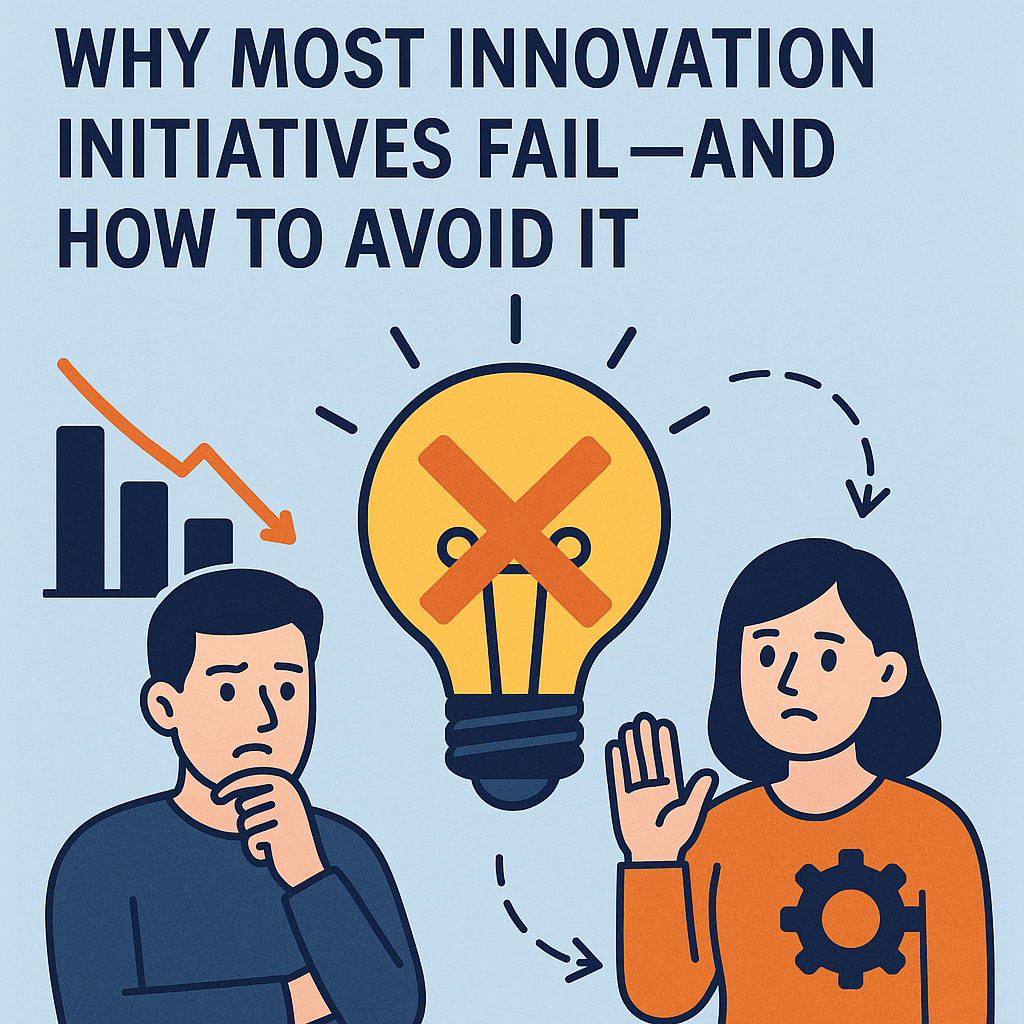
Understanding the Pitfalls of Innovation Initiatives
Innovation initiatives often promise transformative growth and competitive advantage, yet a significant number fail to deliver on their potential. Understanding the common pitfalls is crucial for organizations striving to innovate effectively. One of the primary reasons for failure is the absence of a clear vision. When leaders do not articulate a solid direction or purpose for their innovation strategy, teams may lack alignment and focus, resulting in fragmented efforts that dilute resources and potential impact. A clear roadmap is essential for guiding teams toward a common objective.
Another prominent factor contributing to the failure of innovation initiatives is insufficient stakeholder buy-in. Successful innovation requires the active support of key stakeholders, including executives, employees, and even customers. Without their engagement, initiatives may struggle to gain momentum or achieve necessary resources. For instance, a technology company may embark on developing a new product, but if internally there is skepticism or resistance from departments such as marketing or sales, the initiative might face significant obstacles in execution.
The allocation of resources is equally vital. Innovation often requires investment in both time and financial resources. Companies that fail to allocate adequate funding or personnel to innovation projects may compromise their potential for success. A notable example is a large retail organization that launched an innovation lab but failed to provide the necessary staff to operate it, leading to unfulfilled promises and eventual closure of the initiative.
Lastly, fostering a culture that supports experimentation is essential. In organizations where failure is stigmatized, employees may hesitate to take risks, limiting creativity and exploration. For instance, a pharmaceutical company that punishes failed drug trials may inadvertently stifle innovative treatments. By addressing these common pitfalls, organizations can enhance their innovation capability and increase the likelihood of successful outcomes.
Creating Ideal Conditions for Innovation Success
Successful innovation initiatives are critical for organizations aiming to maintain a competitive edge in today’s rapidly evolving market. To establish ideal conditions for innovation success, several key factors must be integrated into the organizational framework. First and foremost, developing a robust innovation strategy is essential. This strategy should be well-defined, outlining clear objectives that align with the overall goals of the company. By ensuring that innovation initiatives are strategically aligned, organizations can better direct their resources and efforts toward promising projects.
Another fundamental element in fostering an environment conducive to innovation is the cultivation of an inclusive and open culture. In such an environment, employees feel empowered to share their ideas without fear of judgment. This inclusivity allows for diverse perspectives, which can lead to novel solutions and enhancement of the innovation process. Creating an atmosphere where team members can collaborate freely encourages creativity and ensures that innovation initiatives are reflective of input from various departments.
Leadership support serves as a cornerstone for successful innovation. Leaders must not only endorse innovation initiatives but also actively participate and demonstrate commitment. By allocating necessary resources, including time and funding, leaders can inspire confidence among employees. Additionally, fostering cross-functional collaboration is vital for bridging gaps between departments, thereby harnessing the collective expertise to drive innovation forward.
Another critical factor is the investment in employee training and development. Providing continuous learning opportunities equips employees with the skills necessary to adapt to innovation demands. When staff members feel supported in their professional growth, they are more likely to engage actively in innovation initiatives. Ensuring that these elements are in place can significantly increase the success rates of innovation initiatives and ultimately contribute to the organization’s long-term viability in the marketplace.
Real-World Example of Innovation Success
One notable example of a successful innovation initiative is found within the corporate framework of Adobe Systems. Adobe, a leader in digital media and marketing solutions, launched a transformative project known as the Adobe Creative Cloud, which significantly reinvented its business model. This innovation not only expanded its product accessibility but also addressed the common pitfalls that often derail similar initiatives.
The initial challenge Adobe faced was transitioning from a traditional software licensing model to a subscription-based service. Many organizations struggle with adopting new business models, often due to resistance from both employees and customers. However, Adobe effectively communicated the long-term benefits of this shift, emphasizing ease of software updates and continual customer engagement. Through targeted marketing strategies and customer feedback, they built a strong case for innovation that resonated well within their community.
Additionally, Adobe embraced the concept of cross-functional collaboration. By encouraging teamwork across various departments, including sales, marketing, and development, Adobe was able to leverage diverse insights regarding customer needs. This collaborative approach not only fostered creativity but also helped mitigate the inherent risks associated with innovation by ensuring that multiple perspectives were considered in the decision-making process.
Moreover, Adobe implemented iterative testing and development, which allowed them to refine their offerings in real-time based on user feedback. This agile methodology is critical in any innovation initiative as it enables organizations to pivot quickly, respond to market demands, and enhance their products continuously. As a result, the Adobe Creative Cloud has become a cornerstone of their success, attracting millions of subscribers and generating significant recurring revenue.
Through this real-world example, organizations can glean important lessons on managing innovation initiatives effectively. By emphasizing communication, collaboration, and adaptability, companies can significantly increase their chances of successfully achieving their innovation goals.
Strategies to Sustain Innovation Over Time
Maintaining and sustaining innovation within an organization requires a multifaceted approach that integrates continuous learning, adaptation, and regular evaluation of initiatives. One of the core strategies involves fostering a culture of continuous learning. This means empowering employees to acquire new skills, share knowledge, and stay abreast of industry trends. Implementing regular training programs and workshops can encourage teams to think creatively and be more open to innovative ideas. By embedding a mindset of lifelong learning within the company’s ethos, employees are more likely to contribute original concepts that drive innovation forward.
Equally important is the establishment of mechanisms for ongoing evaluation of innovation initiatives. Organizations should adopt a framework for assessing the effectiveness of their innovation strategies frequently. This could involve setting clear performance indicators and metrics that align with the organization’s innovation objectives. Regular assessments can provide valuable insights into what works, what doesn’t, and what needs adjustment, allowing teams to pivot and refine their strategies effectively. This iterative approach ensures that innovation remains relevant and aligned with evolving market demands.
Creating feedback loops is another vital strategy for sustaining innovation. By fostering open communication channels within teams and across departments, organizations can encourage constructive feedback on new ideas and projects. Implementing regular brainstorming sessions, innovation forums, or cross-functional collaborations can stimulate dialogue and spark creativity. Additionally, seeking feedback from customers and stakeholders ensures that the innovation process resonates with the target audience, thereby increasing the likelihood of success.
In conclusion, these strategies — promoting continuous learning, implementing ongoing evaluations, and facilitating feedback loops — form the foundation for significant, sustained innovation. By embedding these practices into the organizational culture, businesses can maintain momentum and ensure that their innovation efforts yield long-term success. Investing in these areas is crucial for any organization aiming to thrive in a rapidly changing marketplace.
- Stunning 4K HDMI Display – Extend your screen in crystal-clear 4K resolution. Perfect for presentations, streaming movie…
- 3-in-1 Multiport USB C Hub – Expand your device’s capabilities with a 3-in-1 USB-C adapter — includes 4K HDMI output, US…
- Super-Speed USB 3.0 Transfer – Transfer large files in seconds with USB 3.0’s high-speed data rate up to 5Gbps. Compatib…




